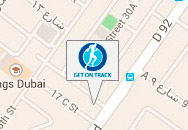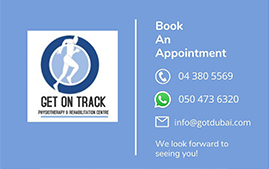Call Us Today!
04 380 55 69

Center Address :
Al Wasl Road, Umm Suqeim 3
Dubai, United Arab Emirates
Telephone : 04 380 55 69
Email : [email protected] 

Trunk
Osteoporosis And Spinal Fractures
As we get older, our bones thin and its strength decreases. Osteoporosis is a disease in which bones become very weak and are more likely to break. It often develops unnoticed over many years, with no symptoms or discomfort until a bone breaks.
Nonsurgical Treatment:
Most people who suffer a vertebral compression fracture get better within 6 to 8 weeks without specific treatment to repair the fracture. In some cases, patients are instructed to wear a brace to restrict movement and allow the vertebral compression fracture to heal. It is essential to visit your Physiotherapist for a rehabilitation program which focuses on getting you back to normal life and normal mobility.
Surgical Treatment:
If you have severe pain that does not respond to initial treatment measures, then surgery may be considered.
Thoracic And Lumbar Spine Fractures
The most common fractures of the spine occur in the midback and lower back or at the connection of the two mentioned. These fractures are typically caused by high-velocity accidents, such as a car crash or fall from height. The primary symptom is moderate to severe back pain that is made worse by movement. The treatment plan for a fracture will depend on:
- Other injuries and their treatment
- The particular fracture pattern
Regardless of whether the patient is treated with surgery, rehabilitation will be necessary after the injury has healed. The goals of rehabilitation are to reduce pain, regain mobility, and return the patient to as close to pre injury state as possible.
Spondylolysis And Spondylolisthesis
The most common cause of low back pain in adolescent athletes that can be seen on X-ray is a stress fracture in one of the bones that make up the spinal column. Technically, this condition is called spondylolysis. It usually affects the fifth vertebra in the lower back and, much less commonly, the fourth vertebra.
Nonsurgical Treatment:
The individual should take a break from the activities until symptoms go away, as they often do. Occasionally, a back brace and physical therapy may be recommended. In most cases, activities can be resumed gradually and there will be few complications or recurrences. Stretching and strengthening exercises for the back and abdominal muscles can help prevent future recurrences of pain.
Surgical Treatment:
Surgery may be needed if slippage progressively worsens or if back pain does not respond to nonsurgical treatment and begins to interfere with activities of daily living.
Lumbar Disk Herniation
Sometimes called a slipped or ruptured disk, a herniated disk most often occurs in your lower back. It is one of the most common causes of low back and leg pain (sciatica). Improperly lifting heavy objects can cause a herniated disk. Usually patient can feel: -Back pain Patient has to go through Physical examination which include, neurological test, strait leg raise (SLR), Muscle power test and many more specific tests if necessary. Nonsurgical Treatment: Unless there are neurological deficits indicated by muscle weakness, and difficulty in walking, conservative care is the first course of treatment. Physiotherapy can help you by application of specific exercises programs which will include self mobilsation, stretching, strengthening of trunk muscles. Surgical Treatment: Rehabilitation
-Leg and/or foot pain (sciatica)
-Numbness in the leg and/or foot
-Weakness in the leg and /or foot
-Loss of bladder or bowel control (extremely rare)
A small percentage of patients with lumbar disk Herniation require surgery. Surgery for lumbar herniated disk is controversial.
All patients require physical therapy after surgery to bring its trunk movement in to the functional stage. Patients who opt for nonsurgical care can return to their normal activities as soon as their pain is manageable.
Lumbar Spinal Canal Stenosis
These normal wear-and-tear effects of aging can lead to narrowing of the spinal canal. This condition is called spinal stenosis. Arthritis is the most common cause of spinal stenosis. In the spine, arthritis can result as the disk degenerates and loses water content. Back pain Burning pain in buttocks or legs (sciatica) Numbness or tingling in buttocks or legs Weakness in the legs or “foot drop” Less pain with leaning forward or sitting Although nonsurgical methods do not improve the narrowing of the spinal canal, many people report that these treatments do help relieve symptoms. Physiotherapy Anti-inflammatory medications Steroid injections Chiropractic manipulation Surgical Treatment: Laminectomy – This procedure involves removing the bone, bone spurs, and ligaments that are compressing the nerves. Spinal fusion – If arthritis has progressed to spinal instability, a combination of decompression and stabilization or spinal fusion may be recommended. Physiotherapy and Rehabilitation Your physiotherapist will show you exercises to build and maintain strength, endurance, and flexibility for spinal stability. Your physiotherapist will create an individualized program, taking into consideration your health and history.
In case of stenosis, patients can experience:
Nonsurgical Treatment:
Stretching exercises, massage, and lumbar and abdominal strengthening often help manage symptoms.
Because stenosis pain is caused by pressure on a spinal nerve, reducing swelling around the nerve may relieve pain.
Cortisone injections can decrease swelling, as well as pain. It is not recommended to receive these, however, more than 3 times per year.
Manipulation of the spine in these cases can worsen symptoms or cause other injuries.
Surgery for lumbar spinal stenosis is generally reserved for patients who have poor quality of life due to pain and weakness. Be sure to discuss the advantages and disadvantages of surgery with your doctor.
Healthy patients who undergo just decompression may go home the same or next day, and may return to normal activities after only a few weeks.
Deformity Of Columnae Vertebrae
- Congenital Scoliosis
- Congenital Torticollis (Twisted Neck)
- Kyphosis (Roundback) of the Spine
- Scoliosis
- Scoliosis in Children and Adolescents
Congenital Scoliosis
Congenital scoliosis is a sideways curvature of the spine that is caused by a defect that was present at birth Even though congenital scoliosis is present at birth, it is sometimes impossible to see any spine problems until a child reaches adolescence.
Scoliosis is not painful, so if the curvature is not detected at birth, it can go undetected until there are obvious signs.
The physical signs:
-Tilted, uneven shoulders, with one shoulder blade protruding more than the other
-Prominence of the ribs on one side
-Uneven waistline
-One hip higher than the other
-Overall appearance of leaning to the side
-In rare cases there may be a problem with the spinal cord or nerves that produces weakness, numbness, or a loss of coordination.
Treatment
There are several treatment options for congenital scoliosis. In planning your child’s treatment, team of medical practitioner (Orthopedic Surgeon, Physiotherapist, Orthotist…) will take into account the type of vertebral abnormality, the severity of the curve, and any other health problems your child has.
Nonsurgical Treatment:
Observation
Physiotherapy
Plays a big role in the treatment of scoliosis .Daily exercising is mandatory and it is directed to strengthen the convex side of the curvature and stretch the concave. Further, there is a specific program for de-rotation of vertebrae and self traction. All exercise programs must be monitored by a scoliosis experienced professional physiotherapist and the patient must be trained in the proper home program exercises.
Bracing or casting
Braces or casts are not effective in treating the curvature caused by the congenitally abnormal vertebrae, but they are sometimes used to control compensatory curves where the vertebrae are normally shaped.
Surgical Treatment:
Surgical treatment is reserved for patients who:
- have curves that have significantly worsened during the course of x-ray monitoring
- have severe curves
- have a large deformity of the spine or trunk
- are developing a neurological problem due to an abnormality in the spinal cord
An important goal of surgery is to allow the spine and chest to grow as much as possible. There are several surgical options.
Spinal fusion
Abnormal curved vertebrae are fused together so that they heal into a single, solid bone.
Hemivertebra removal
The partial correction of the curve using metal implants.
Growing rod
Growing rods do not actually grow but can be lengthened with minor surgery that is repeated every 6 to 8 months.
Rehabilitation
Young children usually recover quickly from surgery and are discharged from the hospital within 1 week. Depending on the operation, a child may need to wear a cast or brace for 3 to 4 months. Physiotherapy is part of rehabilitation program protocol. Once they are healed, children are allowed to participate in most of the activities that they had previously participated in.
Kyphosis (Roundback) Of The Spine
The term kyphosis is used to describe the spinal curve that results in an abnormally rounded back.
Diagnosis :
A visit to the doctor is typically brought on by a scoliosis screening examination at school, a child’s or parent’s concern about the cosmetic deformity of a rounded back, or pain.
Types of Kyphosis:
Postural Kyphosis
It is often attributed to slouching. It is more common among girls than boys. It rarely causes pain.
Scheuermann’s Kyphosis
Scheuermann’s kyphosis usually affects the upper spine. It can also occur in the lower back area. If pain is present, it is usually felt at the apex of the curve.
Congenital Kyphosis
In some infants, the spinal column does not develop properly while the fetus is still in the womb.
Surgical treatment may be needed at a very young age.
Treatment
Treatment will depend on the reason for the deformity. An exercise program may help relieve any associated back pain.
Nonsurgical Treatment:
An initial program of conservative treatment that includes exercises and anti-inflammatory medications is recommended for patients with Scheuermann’s kyphosis.
Surgical Treatment:
Surgery may be recommended if the kyphotic curve exceeds 75°. Following surgery physiotherapy and rehabilitation is essential to restore mobility of the vertebral column.